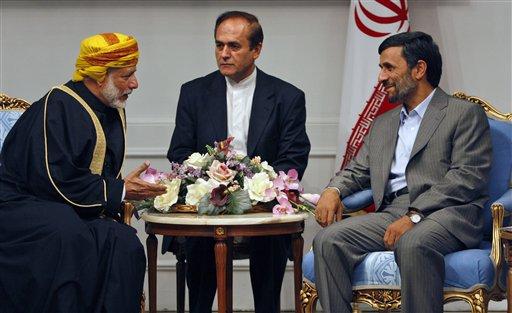|
|
|
Iranian President Mahmoud Ahmadinejad, right, listens to Omani Foreign Minister Yousuf bin Alawi bin Abdullah, left, during their meeting in Tehran, Iran, on July 11, 2009. An unidentified interpreter sits at center. AP Photo by Vahid Salemi. |
In geopolitics, as in astronomy, world powers have a certain gravitational pull. Some nations have less force, choosing to orbit in the atmosphere of larger, more powerful states. Other countries, like China, have several satellite nations in their immediate orbit.
Distracted by Iran’s attempts at nuclear proliferation, the West has not paid much attention to Tehran’s increasing sphere of influence in the Persian Gulf. For many years, the emirate nations of the Gulf have had a strong connection to Saudi Arabia and the United States, providing a natural boundary between the Saudis, Iraqis, and Iranians. In recent months, however, the Gulf countries have begun to reevaluate their relationships with the Islamic Republic.
Today’s post will focus on the nations of Oman and Yemen, two countries that have typically distanced themselves from Iran.
A few days ago in Oman-a historically strong US ally-Omani foreign minister Youssef bin Alawi Abdullah announced closer cooperation with Iran that will remain unfettered by foreign influence. Last August both nations signed seven Memoranda of Understanding (MoUs) covering issues from smuggling and illicit trade to closer economic ties. One agreement of note was an accord on oil cooperation between the Persian Hirbodan Company and the Omani Oil Company. Both nations founded the Hurmuz Petrochemical Company as a joint venture to continue cooperation on construction and energy projects.
Closer economic ties between the Omanis and Iranians have the potential to consolidate Tehran’s grip on the Strait of Hormuz-a 21-mile-wide choke point through which 17 million barrels of oil per day travel from the Persian Gulf countries to destinations in Japan, Europe, and the United States.
Tehran is also suspected of meddling in war-torn Yemen, where Saudi Arabia recently launched a military offensive against the Houthi rebels in the northern territory of Saada. In a statement by Iran’s chief of staff yesterday, General Hassan Firouzabad asserted that the Saudi offensive signals a trend of a “state of terrorism” that will lead to further violence in the region. Both the Yemeni and Saudi governments claim that the Iranians are funding the Houthi rebels because they also adhere to Shiite Islam.
GMU’s Mark Katz argues that this accusation is off base, aimed at securing funds and support from Western nations worried about Iranian hegemony. “The Houthis are indeed Shi’ites, but belong to the Zaidi sect and not the Twelver sect predominant in Iran (indeed, the two sects have historically been rivals),” Katz writes.
In fact, until the recent outbreak of violence, the Yemeni government enjoyed fairly good relations with Tehran. So while the verdict on Iranian meddling in Yemen is out for now, this much is sure: Tehran considers Yemen within the Iranian sphere of influence and wants to ensure that the Western powers (and the Saudis) do not interfere.
How will the United States and its Arab allies respond to Tehran’s covert drive for dominance in the Persian Gulf? So far, no one seems to have any answers.
Are you a dedicated reader of FDD's Long War Journal? Has our research benefitted you or your team over the years? Support our independent reporting and analysis today by considering a one-time or monthly donation. Thanks for reading! You can make a tax-deductible donation here.









1 Comment
Solution: Build a pipeline from Basra to Baghdad, up through Iraqi Kurdistan and eventually to Istanbul. Bypass the Strait of Hormuz entirely.